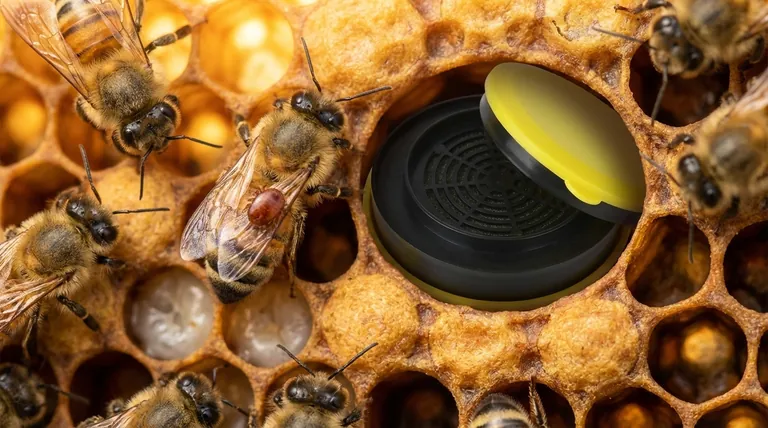The lifespan of a Varroa mite is not fixed; it dramatically adapts to the honey bee colony's seasonal cycle to maximize its survival and reproduction. During the active summer months, a female mite lives for approximately one to two months. In the absence of bee brood during winter, her lifespan extends significantly to six to eight months, allowing her to survive until the next breeding season.
The Varroa mite's survival hinges on its remarkable ability to synchronize its life cycle with its host. Its lifespan contracts for rapid reproduction during the summer bee population boom and expands for survival during the quiet winter period.

The Two-Phase Survival Strategy
A female Varroa mite’s life is divided into two distinct phases, each tied directly to the state of the honey bee colony. This dual strategy is the key to its success as a parasite.
The Reproductive Phase: Summer Proliferation
During spring and summer, when the queen bee is laying eggs prolifically, the mite enters its reproductive phase. An impregnated female mite, known as a foundress mite, detaches from an adult bee and enters a brood cell just before it is capped.
The mite's lifespan of one to two months during this period is optimized for rapid breeding. Inside the protected cell, she feeds on the developing bee larva and lays her eggs, which mature and mate. When the new adult bee emerges from its cell, the original foundress mite and her newly-mated daughters emerge with it, ready to infest other bees and repeat the cycle.
The Phoretic Phase: Winter Survival
As winter approaches and the queen stops laying, the hive becomes broodless. With no brood cells to enter, the mite cannot reproduce and switches to a survival-focused phoretic phase.
During this time, the mite lives exclusively on adult bees, feeding on their fat body tissue to sustain herself. Her metabolism slows, and her lifespan extends to an impressive six to eight months. This allows her to survive the long winter, attached to the long-living winter bees, ensuring she is present to infest the first batch of brood in the spring.
Understanding the Trade-offs and Vulnerabilities
The mite's highly specialized life cycle also creates key vulnerabilities that can be exploited for treatment.
Absolute Dependence on the Hive
The Varroa mite is entirely dependent on the honey bee. It cannot reproduce without access to bee brood and cannot survive for long without an adult bee host to feed on.
The Broodless Period Exposes Mites
The mite’s greatest reproductive strength—hiding inside a capped brood cell—is neutralized during the winter. When all mites are in the phoretic phase on adult bees, they are fully exposed.
This makes the broodless period a critical window for treatment, as therapies can reach the entire mite population at once, without any mites being protected under the wax cappings of brood cells.
Making the Right Choice for Your Goal
Understanding this adaptive life cycle is fundamental to effective Varroa management. Your strategy must change with the seasons, just as the mite's does.
- If your primary focus is controlling summer population growth: Target the mite's rapid reproductive cycle with treatments that can manage mite levels while brood is present, preventing populations from exploding.
- If your primary focus is maximizing winter bee health: Treat during the late fall or winter broodless period to knock down the phoretic mite population, ensuring the bees that raise the first spring generation are healthy.
- If your primary focus is a long-term integrated strategy: Monitor mite levels continuously and synchronize your treatments to target the mite's vulnerabilities in both its reproductive (summer) and phoretic (winter) phases.
By aligning your management strategy with the Varroa's biology, you can effectively disrupt its life cycle and protect your colonies.
Summary Table:
| Season | Mite Phase | Lifespan | Key Activity |
|---|---|---|---|
| Spring/Summer | Reproductive | 1-2 months | Breeding inside brood cells |
| Fall/Winter | Phoretic | 6-8 months | Surviving on adult bees |
Protect Your Apiary with Professional-Grade Solutions
Varroa mites are a constant threat to colony health and honey production. At HONESTBEE, we supply commercial apiaries and beekeeping equipment distributors with the wholesale-focused tools needed to combat these resilient parasites effectively.
Our range of mite control products and equipment is designed to align with the mite's life cycle, helping you:
- Target summer reproduction with precision treatments
- Maximize winter survival of your bees
- Implement integrated pest management strategies
Don't let Varroa mites dictate your season's success. Contact our expert team today to discuss wholesale solutions tailored to your apiary's needs.
Visual Guide

Related Products
- Adjustable Formic and Acetic Acid Dispenser for Bee Mite Treatment
- Varroa Easy Check Mite Tester Kit Counter Alcohol Wash Jar
- Black Plastic Beetle Barn Hive Beetle Trap for Beehives
- HONESTBEE Advanced Ergonomic Stainless Steel Hive Tool for Beekeeping
- HONESTBEE Heavy Duty All Metal Frame Wire Crimper Tool
People Also Ask
- How can beekeepers ensure their hives survive the winter? A Guide to Colony Survival
- What does Chewed Down Brood (CDB) indicate in bee colonies? A Sign of Varroa Mite Infestation
- What is the optimal time for varroa mite control in nucs? Maximize Efficacy with Perfect Timing
- What should beekeepers do to manage varroa mites effectively? Adopt a Proactive Monitoring Strategy
- How do Varroa mites spread between honey bee colonies? Stop Mite Transmission in Your Apiary



















